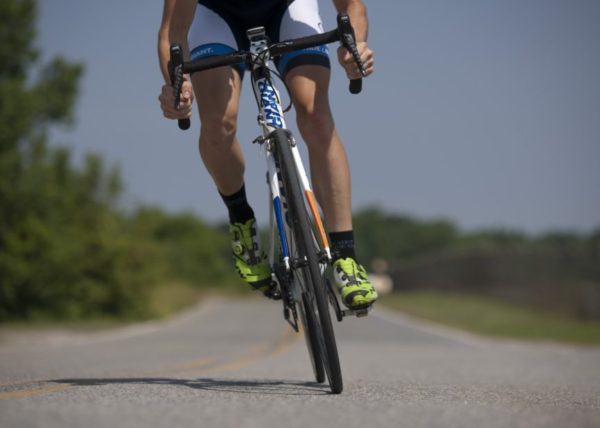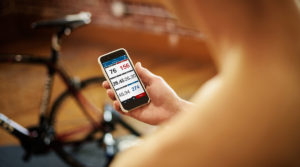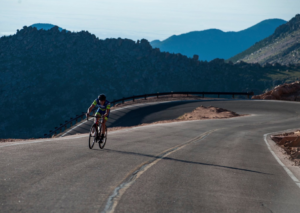Heart rate training is a valuable tool for all athletes, as it helps bypass your brain to listen directly to what your body is telling you. It varies from sport to sport, so keep in mind this article is about cycling heart rate zones in particular.
So, what’s is the big deal with heart rate zones? The zones may not mean much in themselves, but their value comes with understanding how to use them within your training. Heart rate training can be specified to your goals, and can make you stronger, fitter, and faster all the while preventing overtraining and burnout.

What is heart rate?
Your heart rate is measured in the number of times your heart beats per minute (BPM). It is the body’s direct response to what you are doing, whether it’s sitting on your couch or pumping up a hill at full speed.
Your heart rate is measured using two baseline numbers:
- Resting heart rate – Your heart rate when your body is completely relaxed (essentially your minimum heart rate).
- Max heart rate – The highest number your heart beats in the course of one minute. Again, this is for cycling in particular, as your max heart rate for running would be a higher number.
Determine your resting heart rate

You’ll want to measure your resting heart rate first thing in the morning for at a least a week. When you first wake up, and are completely relaxed (avoid testing when you are sick or stressed) measure the number of heartbeats over the course of a minute. This can be done easily with a heart rate monitor or even most smartphones. If you don’t have either of these, then find your pulse on your wrist or neck, set a timer for one minute, and count the number of beats.
Once you have done this once a day for a week, add up each day and divide by 7. This will give you your average resting heart rate. Keep in mind, the more fit you become, the lower your resting heart rate will be as your body becomes more efficient.
Determine your maximum heart rate
There are a variety of ways to determine your maximum heart rate, with the most accurate being a visit to your  doctor for a stress test. However, you can also do a simple test yourself.
doctor for a stress test. However, you can also do a simple test yourself.
First, find a hill climb that takes you at least 10 minutes on your bike and is not so steep that you have to stand up out of the saddle at all. Before heading up the hill, warm up for a minimum of 15 minutes, then take to the hill working up to sprinting as fast as you can for roughly 10 minutes. When you can’t go any faster, stand up in the saddle and sprint for a further 45 seconds. Take your heart rate immediately after, or use the highest heart rate recorded on your monitor – this will be your max heart rate.
Heart rate zone training
Once you have these two parameter numbers, you will then be able to breakdown your heart rate into zones. There are 5 basic zones when it comes to cycling:
Zone 1 – Recovery (50 – 64% of max HR)
Known as ‘active recovery,’ this zone can be used between cycling intervals, or for rest days when training. This zone will flush lactic acid from your body and help you loosen up sore muscles.
Zone 2 – Aerobic Endurance (65 – 74% of max HR)
Think if this is as your base pace, especially if you’re a beginner cyclist. This is the zone where you should spend a lot of your time, and is the foundation for building endurance and burning fat. You will be working hard enough to feel it, but able to maintain over long distances and remain able to carry on a conversation.
Zone 3 – Aerobic Threshold (75 – 84% of max HR)
This zone can be described as your push pace, or comfortably hard. You are building strength and muscle, but you’ll want to be careful about just how much time you spend in this zone. At the end of a ride you will feel tired, but not have pushed yourself hard enough to see real progress (can reach a plateau in your fitness).
Zone 4 – Lactate Threshold (85 – 91% of max HR)
The lactate threshold is the zone in which lactic acid starts to accumulate in the bloodstream, as lactate clearance is no longer able to keep up with lactate production. This will be used most commonly in interval training as it is challenging and cannot be sustained for extended period of time. Within this zone you are bettering your maximum performance, improving lung capacity, and improving high-intensity endurance.
Zone 5 – VO2 (92 – 100% of max HR)
The VO2 zone can be described as the numerical measurement of the body’s ability to consume oxygen during intense exercise, in other words respiratory endurance. Most cannot maintain this zone for more than 5 minutes. Your lungs will be burning and you will be breathing (or gasping) heavily. Although difficult, this type of training will make your body more efficient.
How much time you should be spending in each of these zones has a lot to do with your goals and current training plan. Check out “Heart Rate Zone Training for Cyclists” for some examples to get started with your own heart rate zone training.